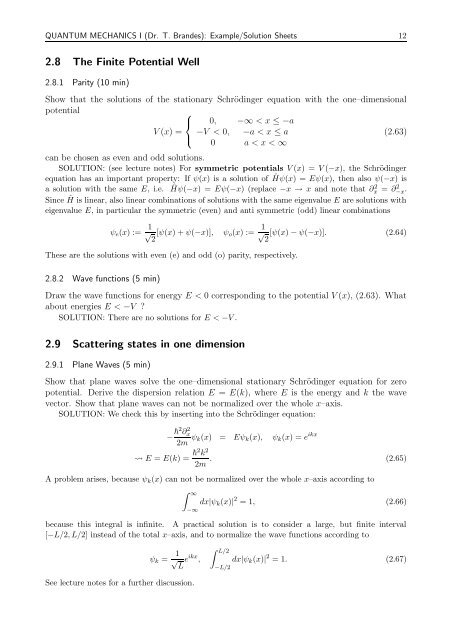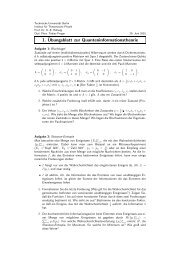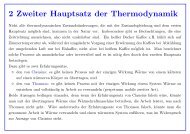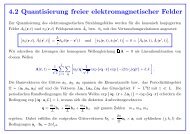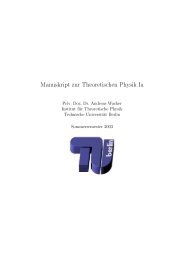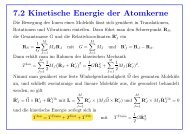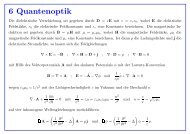1.1 The Radiation Laws and the Birth of Quantum Mechanics
1.1 The Radiation Laws and the Birth of Quantum Mechanics
1.1 The Radiation Laws and the Birth of Quantum Mechanics
Create successful ePaper yourself
Turn your PDF publications into a flip-book with our unique Google optimized e-Paper software.
QUANTUM MECHANICS I (Dr. T. Br<strong>and</strong>es): Example/Solution Sheets 12<br />
2.8 <strong>The</strong> Finite Potential Well<br />
2.8.1 Parity (10 min)<br />
Show that <strong>the</strong> solutions <strong>of</strong> <strong>the</strong> stationary Schrödinger equation with <strong>the</strong> one–dimensional<br />
potential<br />
⎧<br />
⎨ 0, −∞ < x ≤ −a<br />
V (x) = −V < 0, −a < x ≤ a<br />
(2.63)<br />
⎩<br />
0 a < x < ∞<br />
can be chosen as even <strong>and</strong> odd solutions.<br />
SOLUTION: (see lecture notes) For symmetric potentials V (x) = V (−x), <strong>the</strong> Schrödinger<br />
equation has an important property: If ψ(x) is a solution <strong>of</strong> Ĥψ(x) = Eψ(x), <strong>the</strong>n also ψ(−x) is<br />
a solution with <strong>the</strong> same E, i.e. Ĥψ(−x) = Eψ(−x) (replace −x → x <strong>and</strong> note that ∂x 2 = ∂2 −x .<br />
Since Ĥ is linear, also linear combinations <strong>of</strong> solutions with <strong>the</strong> same eigenvalue E are solutions with<br />
eigenvalue E, in particular <strong>the</strong> symmetric (even) <strong>and</strong> anti symmetric (odd) linear combinations<br />
ψ e (x) := 1 √<br />
2<br />
[ψ(x) + ψ(−x)], ψ o (x) := 1 √<br />
2<br />
[ψ(x) − ψ(−x)]. (2.64)<br />
<strong>The</strong>se are <strong>the</strong> solutions with even (e) <strong>and</strong> odd (o) parity, respectively.<br />
2.8.2 Wave functions (5 min)<br />
Draw <strong>the</strong> wave functions for energy E < 0 corresponding to <strong>the</strong> potential V (x), (2.63). What<br />
about energies E < −V <br />
SOLUTION: <strong>The</strong>re are no solutions for E < −V .<br />
2.9 Scattering states in one dimension<br />
2.9.1 Plane Waves (5 min)<br />
Show that plane waves solve <strong>the</strong> one–dimensional stationary Schrödinger equation for zero<br />
potential. Derive <strong>the</strong> dispersion relation E = E(k), where E is <strong>the</strong> energy <strong>and</strong> k <strong>the</strong> wave<br />
vector. Show that plane waves can not be normalized over <strong>the</strong> whole x–axis.<br />
SOLUTION: We check this by inserting into <strong>the</strong> Schrödinger equation:<br />
− 2 ∂ 2 x<br />
2m ψ k(x) = Eψ k (x), ψ k (x) = e ikx<br />
E = E(k) = 2 k 2<br />
2m . (2.65)<br />
A problem arises, because ψ k (x) can not be normalized over <strong>the</strong> whole x–axis according to<br />
∫ ∞<br />
−∞<br />
dx|ψ k (x)| 2 = 1, (2.66)<br />
because this integral is infinite. A practical solution is to consider a large, but finite interval<br />
[−L/2, L/2] instead <strong>of</strong> <strong>the</strong> total x–axis, <strong>and</strong> to normalize <strong>the</strong> wave functions according to<br />
ψ k = 1 √<br />
L<br />
e ikx ,<br />
∫ L/2<br />
−L/2<br />
dx|ψ k (x)| 2 = 1. (2.67)<br />
See lecture notes for a fur<strong>the</strong>r discussion.


